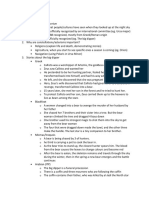0 ratings0% found this document useful (0 votes)
51 viewsDemo Notes
This document provides notes for a demonstration on acids and bases:
1. Chemical indicators are used to determine if a solution is acidic or basic. Indicators change color depending on the pH of the solution.
2. Universal indicator can determine the approximate pH of a solution based on its color. However, different indicators may be needed for more precise measurements or specific pH ranges.
3. Students will test unknown clear solutions by adding universal indicator to determine if they are acidic, basic, or neutral based on the color change. This identifies household substances like vinegar and sodium carbonate.
Uploaded by
api-298474962Copyright
© © All Rights Reserved
Available Formats
Download as DOCX, PDF, TXT or read online on Scribd
0 ratings0% found this document useful (0 votes)
51 viewsDemo Notes
This document provides notes for a demonstration on acids and bases:
1. Chemical indicators are used to determine if a solution is acidic or basic. Indicators change color depending on the pH of the solution.
2. Universal indicator can determine the approximate pH of a solution based on its color. However, different indicators may be needed for more precise measurements or specific pH ranges.
3. Students will test unknown clear solutions by adding universal indicator to determine if they are acidic, basic, or neutral based on the color change. This identifies household substances like vinegar and sodium carbonate.
Uploaded by
api-298474962Copyright
© © All Rights Reserved
Available Formats
Download as DOCX, PDF, TXT or read online on Scribd
You are on page 1/ 3
Demo Notes Acids and Bases
1. Questions 1: What is a chemical indicator? Why do
we use them? When do you think people use them in
real life?
2. Introduce Colour Range and associated pHs of
universal indicator using a ppt.
a. Why is universal indicator good?
b. Why would I use a different indicator instead of
universal indicator?
3. Show students the 3 beakers of clear liquid (sodium
carbonate may be cloudy if not completely dissolved)
a. How can I determine what these are?
i. Smell them how do we safely smell
chemicals?
ii. Drink them is that safe? (hopefully not an
answer)
1. No! Why?
iii. Look at them they all look the same or
close to the same
iv. Check the pH how?
b. How can I find out if it is an acid, a base, or
neutral? (only if no one answers check the pH).
4. Do procedure elicited by students for using an
indicator (throughout ask students what do I do
next?)
a. Pour some of the solution into a different beaker
and add the universal indicator (repeat for all
three solutions)
i. What type of solution is it?
1. How do you know that?
2. What chemical could it be?
a. Hint: you can find it in your house
b. Tell students what the different chemicals are.
i. Does someone know the chemical name of
vinegar? How about the household name of
sodium carbonate?
5. Pour water into a graduated cylinder and add some
acid to it using an eyedropper
a. Before adding acid
i. What will happen if I add acid to water?
What will we see?
b. After adding acid
i. What happened? Why?
ii. Why did the colour start at the top and
move to the bottom?
iii. What can I do to make the colour change
more quickly?
6. Add base to the cylinder using an eyedropper
a. Before adding base
i. What do you think will happen if I add base
to the acidic solution?
1. Why?
b. After adding a little base
i. What happened? Why?
ii. Why didnt the colour change?
iii. How can we make the colour change? Why?
c. After adding more base (to make it green)
i. What kind of solution do we have now?
ii. What happened? Why?
iii. What will happen if I add more base?
d. After adding more base (to make it purple)
i. What kind of solution do we have now?
Why?
ii. What happened? Why?
7. Experiment Summary
a. What does this experiment tell us about pH
indicators?
i. Are they good for all pHs?
ii. Do they tell us a specific pH for the solution?
b. Why did I choose to use vinegar, water, and
soda ash?
You might also like
- ASNT Liquid Penetrant Testing Level - II Questions and Answers88% (25)ASNT Liquid Penetrant Testing Level - II Questions and Answers6 pages
- Report - Expt. 1-Chemical Reactions (15.7.22) - Pham Thai QuocNo ratings yetReport - Expt. 1-Chemical Reactions (15.7.22) - Pham Thai Quoc8 pages
- Class 7 Science NCERT Solution Chapter 4 Acids, Bases and SaltsNo ratings yetClass 7 Science NCERT Solution Chapter 4 Acids, Bases and Salts30 pages
- Instantly download the full Introduction to General Organic and Biochemistry 11th Edition Bettelheim Test Bank and start reading.100% (4)Instantly download the full Introduction to General Organic and Biochemistry 11th Edition Bettelheim Test Bank and start reading.55 pages
- Download full Introduction to General Organic and Biochemistry 11th Edition Bettelheim Test Bank all chapters100% (17)Download full Introduction to General Organic and Biochemistry 11th Edition Bettelheim Test Bank all chapters52 pages
- Access Answers To NCERT Solutions For Class 7 Science Chapter 5No ratings yetAccess Answers To NCERT Solutions For Class 7 Science Chapter 57 pages
- Introduction to General Organic and Biochemistry 11th Edition Bettelheim Test Bank - Read Now Or Download For A Complete Experience100% (3)Introduction to General Organic and Biochemistry 11th Edition Bettelheim Test Bank - Read Now Or Download For A Complete Experience48 pages
- Grade 6 PPT - Science - Q1 - W2 - Day 1No ratings yetGrade 6 PPT - Science - Q1 - W2 - Day 117 pages
- Introduction to General Organic and Biochemistry 11th Edition Bettelheim Test Bank - Free Download Available In PDF DOCX FormatNo ratings yetIntroduction to General Organic and Biochemistry 11th Edition Bettelheim Test Bank - Free Download Available In PDF DOCX Format63 pages
- 1st Quarter Lesson 1 Define What A Mixture IsNo ratings yet1st Quarter Lesson 1 Define What A Mixture Is5 pages
- 1st Quarter Lesson 1 Define What A Mixture Is100% (1)1st Quarter Lesson 1 Define What A Mixture Is5 pages
- Introduction to General Organic and Biochemistry 11th Edition Bettelheim Test Bankinstant download100% (3)Introduction to General Organic and Biochemistry 11th Edition Bettelheim Test Bankinstant download48 pages
- Introduction to General Organic and Biochemistry 11th Edition Bettelheim Test Bankpdf download100% (3)Introduction to General Organic and Biochemistry 11th Edition Bettelheim Test Bankpdf download44 pages
- Introduction to General Organic and Biochemistry 11th Edition Bettelheim Test Bank pdf download100% (2)Introduction to General Organic and Biochemistry 11th Edition Bettelheim Test Bank pdf download60 pages
- 1st Quarter Lesson 10 Show That A Suspension Is A Heterogeneous MixtureNo ratings yet1st Quarter Lesson 10 Show That A Suspension Is A Heterogeneous Mixture4 pages
- Acids, Bases and Salts: Factual QuestionsNo ratings yetAcids, Bases and Salts: Factual Questions17 pages
- 1st Quarter Lesson 5 Describe What Is A Homogenous MixtureNo ratings yet1st Quarter Lesson 5 Describe What Is A Homogenous Mixture4 pages
- SCI6 W2 Q1 Solutions, Factors Affecting SolubilityNo ratings yetSCI6 W2 Q1 Solutions, Factors Affecting Solubility100 pages
- CBSE Class 9 Chemistry Chapter-2 (Part 3)No ratings yetCBSE Class 9 Chemistry Chapter-2 (Part 3)3 pages
- Organic Reaction Mechanisms Selected Problems and Solutions 2nd Edition Groutas Rathnayake 2024 scribd downloadNo ratings yetOrganic Reaction Mechanisms Selected Problems and Solutions 2nd Edition Groutas Rathnayake 2024 scribd download37 pages
- F 1852 - 04 "Twist Off" Type Tension Control Structural BoltNutWasherNo ratings yetF 1852 - 04 "Twist Off" Type Tension Control Structural BoltNutWasher8 pages
- 3 Characteristics and Examination of SewageNo ratings yet3 Characteristics and Examination of Sewage37 pages
- Test Report 180 - Copper Tape Round Test Clamp - RC70GNo ratings yetTest Report 180 - Copper Tape Round Test Clamp - RC70G19 pages
- Brands You Trust.: Industrial Diaphragm ValvesNo ratings yetBrands You Trust.: Industrial Diaphragm Valves20 pages
- Hydrocarbons DPP 07 Yakeen NEET 2.0 2025 (Legend)No ratings yetHydrocarbons DPP 07 Yakeen NEET 2.0 2025 (Legend)3 pages
- Grade 7 - Second Quarter SCIENCE by REWARD FULGUERASNo ratings yetGrade 7 - Second Quarter SCIENCE by REWARD FULGUERAS4 pages
- Catalysts: Mechanistic Investigation of The Reduction of NO Over Pt-And Rh-Based LNT CatalystsNo ratings yetCatalysts: Mechanistic Investigation of The Reduction of NO Over Pt-And Rh-Based LNT Catalysts14 pages
- M.rigaud Aluminaandmagnesia BasedcastablescontaininggraphiteNo ratings yetM.rigaud Aluminaandmagnesia Basedcastablescontaininggraphite15 pages
- European Steel and Alloy Grades: Gx5Crnicu16-4 (1.4525)No ratings yetEuropean Steel and Alloy Grades: Gx5Crnicu16-4 (1.4525)2 pages
- Hazards of Organic Chloride To Petroleum Processing in Chinese Refineries and Industrial CountermeasuresNo ratings yetHazards of Organic Chloride To Petroleum Processing in Chinese Refineries and Industrial Countermeasures4 pages
- Evelyn Reategui-Zirena Et Al 2013 PAH ConcentrationsNo ratings yetEvelyn Reategui-Zirena Et Al 2013 PAH Concentrations14 pages




























































































